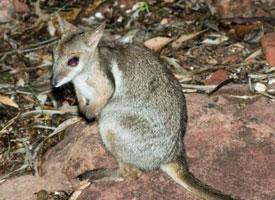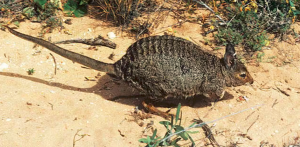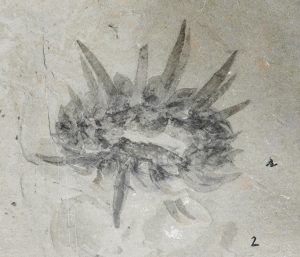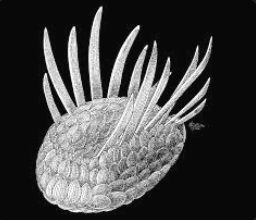Go offline with the Player FM app!
Episode 390: The Wallaby and Wiwaxia
Manage episode 430105644 series 3451304
Thanks to Jaxon and Lorenzo for their suggestions this week!
Further reading:
Rock-wallaby bite size ‘packs a punch’
Tiny Australian wallaby the last living link to extinct giant kangaroos
Extraordinary Fossil of Giant Short-Faced Kangaroo Found in Australia
Wiwaxia corrugata – The Burgess Shale
The nabarlek:

The banded hare-wallaby:

Wiwaxia was a little less cute than wallabies are:

An artist’s rendition of what Wiwaxia might have looked like when alive [picture from last page linked above]:

Show transcript:
Welcome to Strange Animals Podcast. I’m your host, Kate Shaw.
Every so often I get an animal suggestion that I’m positive we’ve already covered, but then I’m flabbergasted when it turns out we haven’t. That’s the case for the animals we’ll learn about this episode, with thanks to Jaxon and Lorenzo!
A while ago, Jaxon left us a nice review and suggested we talk about wallabies. I was CONVINCED we’d talked about the wallaby repeatedly, but I think I was thinking about the wombat. We’ve hardly ever mentioned the wallaby, and it’s such a great animal!
The wallaby is a marsupial that basically looks like a miniature kangaroo, although some species grow pretty large. The resemblance makes sense because kangaroos and wallabies are closely related, but everything else about the wallaby family tree is confusing. That’s because there are a lot of animals called wallabies that aren’t actually the same type of animal. “Wallaby” is just a catchall term used by people to describe any animal that looks kind of like a miniature kangaroo.
Wallabies are native to Australia and New Guinea, but various species have been introduced to other places where they’re invasive, including New Zealand, France, England, Scotland, and Hawaii. Most of these non-native populations happened by accident when pets or zoo animals escaped into the wild, but some were introduced on purpose by people who didn’t know they were causing damage to the local ecosystems.
One thing everyone knows about kangaroos, which is also true for wallabies, is that they hop instead of running. Their hind legs are extremely strong with big feet, and in fact the name of the family they share, Macropodidae, means big feet. So, you know, Bigfoot exists but maybe doesn’t look like most people think. The animal hops by leaning forward and jumping, with its big hind feet leaving the ground at about the same time, and landing at the same time too before it bounces again. Its big tail helps it balance. But there’s a lot more to this hopping than you might think.
While the wallaby or kangaroo has strong leg muscles, what’s even more important is that it has very strong, very elastic tendons in its legs. These basically act like massively strong rubber bands. When you stretch a rubber band, it stores energy that it releases when you let go of it and it snaps back and whips you in the thumb and you wonder why you did that because it hurt. The tendons in the wallaby’s legs store energy when it hops, and when it lands, the energy releases and helps bounce the animal right back into the next hop. Once it gets going, its muscles are only doing a fraction of the work to keep it hopping at high speed. Even better for the animal, a lot of its breathing is regulated by its movements when it’s hopping, so it always has plenty of oxygen to power its body while moving fast. When it lands after a bounce, the impact pushes its breath out of its lungs, but the action of bringing its legs forward helps suck fresh air in. It’s an incredibly efficient way to move, and allows the animal to travel long distances to find food and water without spending a lot of energy.
Wallabies eat plants, and naturally the bigger species can eat bigger, tougher plants than smaller species. The exception is the dwarf rock-wallaby, according to a study published in March of 2024. There are over a dozen species of rock-wallaby, but in general they live in small groups in rocky areas. They’re nocturnal and spend the day sleeping in shady areas among the rocks, under rock overhangs, or in small caves in cliffs. At night they come out to find plants, but because they live in such harsh environments, most of the plants are pretty tough. Two species of dwarf rock-wallaby in particular turn out to have incredibly strong jaws for their size, as strong as the jaws of much larger species. Their teeth are also larger to help them grind up tough plants, and one species, called the nabarlek wallaby, even grows new molars throughout its life as the old ones wear down. That’s the only marsupial known to grow new molars throughout its life.
The nabarlek is reddish-gray in color and only weighs about 3 ½ pounds at most, or 1.6 kilograms, and is barely more than a foot long, or 30 cm, with its fluffy tail almost doubling that length. When it hops, it curls its tail up over its back. It eats grass, ferns, and other tough plants. Like most species of wallaby, it’s endangered due to habitat loss and introduced predators like foxes.
Another very small wallaby is the banded hare-wallaby, which only has a few small populations remaining on a few islands. It’s almost exactly the same size and weight as the nabarlek and is gray with lighter speckles and darker stripes on its back. It’s also nocturnal and lives in brushy areas where it can hide easily.
Even though these wallabies are smaller than domestic cats, some 45,000 years ago there used to be a type of kangaroo that was extremely large. The short-faced kangaroo stood as tall as a big grey or red kangaroo, about five feet tall, or 1.5 meters, but was much bulkier—as much as twice the weight of a modern kangaroo. It was so heavy that some researchers think it couldn’t hop but actually walked on its hind legs instead like a person. (Bigfoot.)
A few years ago, scientists comparing the genetic sequence of the short-faced kangaroo to other macropods discovered that this big strong kangaroo’s closest living relative was the tiny banded hare-wallaby.
Our next animal is a suggestion from Lorenzo, who sent a bunch of requests a while back. Before we talk about the animal, I should probably explain the situation with the List. This is the list of topics that I want to cover, a lot of them suggestions from listeners and a lot of them animals I’ve added myself. It started out as a simple Word document, but after a few years I moved it over to a spreadsheet and divided it into categories. There’s a page for mammals, a page for birds, and so on. I copied and pasted Lorenzo’s suggestions into the reptiles page because I recognized the first few as reptiles, or at least therapsids.
Well, at some point I took a closer look at the list of Lorenzo’s suggestions and added a note, “these may not all be reptiles.” Then later I took an even closer look and added another note, “these down here are basal arthropods, why did you put them under reptiles?” But next to today’s animal, at some point I added the note “I think this is a bird.”
Dear listener, Wiwaxia is not a bird. Scientists aren’t actually sure what it is, but 100% it is not a bird. It lived just over half a billion years ago in the early to middle Cambrian period, which we talked about in episode 69 about the Cambrian explosion. That’s when life on earth evolved from relatively simple, tiny organisms to much larger and more complex ones. Many of the Cambrian animals look bizarre and confusing to us today because they’re so different from the animals we’re familiar with, and that’s the case for Wiwaxia.
Wiwaxia grew about 2 inches long at most, or 5 cm, and slightly less wide. It was flat underneath like a slug, and it probably moved sort of like a slug too. The upper part of its body was covered in overlapping plates called sclerites, which acted as armor. As the animal grew older, it also developed spines that grew between the sclerites in two rows, with the longest spines growing 2 inches long, or 5 cm. Modern marine invertebrates have mineralized spines and scales that make them harder, but this hadn’t evolved yet and wiwaxia’s were basically the same material as the rest of the body, but tougher. Both the scales and the spines were shed and regrown every so often.
Like all the other animals in the Cambrian, wiwaxia lived in warm, shallow ocean water. It had a feeding apparatus at its front that had tiny conical teeth, and scientists think it used this feeding apparatus to scrape bacteria off the microbial mats that lived on the sea floor in most places, or it might have lived directly on the sea floor or on rocks. Either way, its feeding apparatus is enough like the radula found in modern mollusks that it’s been tentatively placed in the phylum Mollusca. This means it may be a very distant ancestor of slugs, snails, clams, mussels, oysters, squid, octopuses, and lots of other animals.
Wiwaxia was originally classified as an ancestor or at least a relation of modern polychaete worms, and a lot of scientists still think that’s correct. Since the original description of wiwaxia in 1899, a lot of specimens have been discovered in the Burgess shale in Canada, along with lots more found in China, Russia, the Czech Republic, and Australia, with more fossils found in other places that might be wiwaxia spines.
Because all the Cambrian fossils discovered are flattened, there’s a limit to how much we know about its anatomy when alive. The best fossils are reexamined frequently as new and more powerful methods of study are invented. Wiwaxia was apparently very common throughout the world between about 520 and 505 million years ago, so as more and more fossils are discovered, we’ll definitely learn more about it.
You can find Strange Animals Podcast at strangeanimalspodcast.blubrry.net. That’s blueberry without any E’s. If you have questions, comments, or suggestions for future episodes, email us at strangeanimalspodcast@gmail.com. We also have a Patreon at patreon.com/strangeanimalspodcast if you’d like to support us for as little as one dollar a month and get monthly bonus episodes.
Thanks for listening!
300 episodes
Manage episode 430105644 series 3451304
Thanks to Jaxon and Lorenzo for their suggestions this week!
Further reading:
Rock-wallaby bite size ‘packs a punch’
Tiny Australian wallaby the last living link to extinct giant kangaroos
Extraordinary Fossil of Giant Short-Faced Kangaroo Found in Australia
Wiwaxia corrugata – The Burgess Shale
The nabarlek:

The banded hare-wallaby:

Wiwaxia was a little less cute than wallabies are:

An artist’s rendition of what Wiwaxia might have looked like when alive [picture from last page linked above]:

Show transcript:
Welcome to Strange Animals Podcast. I’m your host, Kate Shaw.
Every so often I get an animal suggestion that I’m positive we’ve already covered, but then I’m flabbergasted when it turns out we haven’t. That’s the case for the animals we’ll learn about this episode, with thanks to Jaxon and Lorenzo!
A while ago, Jaxon left us a nice review and suggested we talk about wallabies. I was CONVINCED we’d talked about the wallaby repeatedly, but I think I was thinking about the wombat. We’ve hardly ever mentioned the wallaby, and it’s such a great animal!
The wallaby is a marsupial that basically looks like a miniature kangaroo, although some species grow pretty large. The resemblance makes sense because kangaroos and wallabies are closely related, but everything else about the wallaby family tree is confusing. That’s because there are a lot of animals called wallabies that aren’t actually the same type of animal. “Wallaby” is just a catchall term used by people to describe any animal that looks kind of like a miniature kangaroo.
Wallabies are native to Australia and New Guinea, but various species have been introduced to other places where they’re invasive, including New Zealand, France, England, Scotland, and Hawaii. Most of these non-native populations happened by accident when pets or zoo animals escaped into the wild, but some were introduced on purpose by people who didn’t know they were causing damage to the local ecosystems.
One thing everyone knows about kangaroos, which is also true for wallabies, is that they hop instead of running. Their hind legs are extremely strong with big feet, and in fact the name of the family they share, Macropodidae, means big feet. So, you know, Bigfoot exists but maybe doesn’t look like most people think. The animal hops by leaning forward and jumping, with its big hind feet leaving the ground at about the same time, and landing at the same time too before it bounces again. Its big tail helps it balance. But there’s a lot more to this hopping than you might think.
While the wallaby or kangaroo has strong leg muscles, what’s even more important is that it has very strong, very elastic tendons in its legs. These basically act like massively strong rubber bands. When you stretch a rubber band, it stores energy that it releases when you let go of it and it snaps back and whips you in the thumb and you wonder why you did that because it hurt. The tendons in the wallaby’s legs store energy when it hops, and when it lands, the energy releases and helps bounce the animal right back into the next hop. Once it gets going, its muscles are only doing a fraction of the work to keep it hopping at high speed. Even better for the animal, a lot of its breathing is regulated by its movements when it’s hopping, so it always has plenty of oxygen to power its body while moving fast. When it lands after a bounce, the impact pushes its breath out of its lungs, but the action of bringing its legs forward helps suck fresh air in. It’s an incredibly efficient way to move, and allows the animal to travel long distances to find food and water without spending a lot of energy.
Wallabies eat plants, and naturally the bigger species can eat bigger, tougher plants than smaller species. The exception is the dwarf rock-wallaby, according to a study published in March of 2024. There are over a dozen species of rock-wallaby, but in general they live in small groups in rocky areas. They’re nocturnal and spend the day sleeping in shady areas among the rocks, under rock overhangs, or in small caves in cliffs. At night they come out to find plants, but because they live in such harsh environments, most of the plants are pretty tough. Two species of dwarf rock-wallaby in particular turn out to have incredibly strong jaws for their size, as strong as the jaws of much larger species. Their teeth are also larger to help them grind up tough plants, and one species, called the nabarlek wallaby, even grows new molars throughout its life as the old ones wear down. That’s the only marsupial known to grow new molars throughout its life.
The nabarlek is reddish-gray in color and only weighs about 3 ½ pounds at most, or 1.6 kilograms, and is barely more than a foot long, or 30 cm, with its fluffy tail almost doubling that length. When it hops, it curls its tail up over its back. It eats grass, ferns, and other tough plants. Like most species of wallaby, it’s endangered due to habitat loss and introduced predators like foxes.
Another very small wallaby is the banded hare-wallaby, which only has a few small populations remaining on a few islands. It’s almost exactly the same size and weight as the nabarlek and is gray with lighter speckles and darker stripes on its back. It’s also nocturnal and lives in brushy areas where it can hide easily.
Even though these wallabies are smaller than domestic cats, some 45,000 years ago there used to be a type of kangaroo that was extremely large. The short-faced kangaroo stood as tall as a big grey or red kangaroo, about five feet tall, or 1.5 meters, but was much bulkier—as much as twice the weight of a modern kangaroo. It was so heavy that some researchers think it couldn’t hop but actually walked on its hind legs instead like a person. (Bigfoot.)
A few years ago, scientists comparing the genetic sequence of the short-faced kangaroo to other macropods discovered that this big strong kangaroo’s closest living relative was the tiny banded hare-wallaby.
Our next animal is a suggestion from Lorenzo, who sent a bunch of requests a while back. Before we talk about the animal, I should probably explain the situation with the List. This is the list of topics that I want to cover, a lot of them suggestions from listeners and a lot of them animals I’ve added myself. It started out as a simple Word document, but after a few years I moved it over to a spreadsheet and divided it into categories. There’s a page for mammals, a page for birds, and so on. I copied and pasted Lorenzo’s suggestions into the reptiles page because I recognized the first few as reptiles, or at least therapsids.
Well, at some point I took a closer look at the list of Lorenzo’s suggestions and added a note, “these may not all be reptiles.” Then later I took an even closer look and added another note, “these down here are basal arthropods, why did you put them under reptiles?” But next to today’s animal, at some point I added the note “I think this is a bird.”
Dear listener, Wiwaxia is not a bird. Scientists aren’t actually sure what it is, but 100% it is not a bird. It lived just over half a billion years ago in the early to middle Cambrian period, which we talked about in episode 69 about the Cambrian explosion. That’s when life on earth evolved from relatively simple, tiny organisms to much larger and more complex ones. Many of the Cambrian animals look bizarre and confusing to us today because they’re so different from the animals we’re familiar with, and that’s the case for Wiwaxia.
Wiwaxia grew about 2 inches long at most, or 5 cm, and slightly less wide. It was flat underneath like a slug, and it probably moved sort of like a slug too. The upper part of its body was covered in overlapping plates called sclerites, which acted as armor. As the animal grew older, it also developed spines that grew between the sclerites in two rows, with the longest spines growing 2 inches long, or 5 cm. Modern marine invertebrates have mineralized spines and scales that make them harder, but this hadn’t evolved yet and wiwaxia’s were basically the same material as the rest of the body, but tougher. Both the scales and the spines were shed and regrown every so often.
Like all the other animals in the Cambrian, wiwaxia lived in warm, shallow ocean water. It had a feeding apparatus at its front that had tiny conical teeth, and scientists think it used this feeding apparatus to scrape bacteria off the microbial mats that lived on the sea floor in most places, or it might have lived directly on the sea floor or on rocks. Either way, its feeding apparatus is enough like the radula found in modern mollusks that it’s been tentatively placed in the phylum Mollusca. This means it may be a very distant ancestor of slugs, snails, clams, mussels, oysters, squid, octopuses, and lots of other animals.
Wiwaxia was originally classified as an ancestor or at least a relation of modern polychaete worms, and a lot of scientists still think that’s correct. Since the original description of wiwaxia in 1899, a lot of specimens have been discovered in the Burgess shale in Canada, along with lots more found in China, Russia, the Czech Republic, and Australia, with more fossils found in other places that might be wiwaxia spines.
Because all the Cambrian fossils discovered are flattened, there’s a limit to how much we know about its anatomy when alive. The best fossils are reexamined frequently as new and more powerful methods of study are invented. Wiwaxia was apparently very common throughout the world between about 520 and 505 million years ago, so as more and more fossils are discovered, we’ll definitely learn more about it.
You can find Strange Animals Podcast at strangeanimalspodcast.blubrry.net. That’s blueberry without any E’s. If you have questions, comments, or suggestions for future episodes, email us at strangeanimalspodcast@gmail.com. We also have a Patreon at patreon.com/strangeanimalspodcast if you’d like to support us for as little as one dollar a month and get monthly bonus episodes.
Thanks for listening!
300 episodes
All episodes
×Welcome to Player FM!
Player FM is scanning the web for high-quality podcasts for you to enjoy right now. It's the best podcast app and works on Android, iPhone, and the web. Signup to sync subscriptions across devices.




